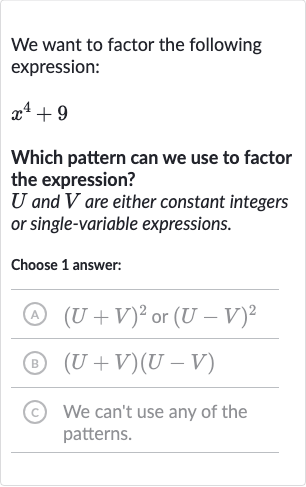AI tutor
Welcome to Bytelearn!
Let’s check out your problem:

We want to factor the following expression:Which pattern can we use to factor the expression? and are either constant integers or single-variable expressions.Choose answer:(A) or (B) (C) We can't use any of the patterns.
Full solution
Q. We want to factor the following expression:Which pattern can we use to factor the expression? and are either constant integers or single-variable expressions.Choose answer:(A) or (B) (C) We can't use any of the patterns.
- Step : Determine Factoring Pattern: The expression is a sum of two terms, where one term is raised to the fourth power and the other term is a constant . We need to determine if there is a factoring pattern that applies to this expression.
- Step : Evaluate Option (A): Option (A) suggests using the square of a binomial pattern, either or . However, these patterns expand to and , respectively. Neither of these patterns match the given expression because there is no middle term in the expression .
- Step : Evaluate Option (B): Option (B) suggests using the difference of squares pattern, , which expands to . This pattern also does not apply because we have a sum, not a difference, and the expression does not represent a difference of squares.
- Step : Evaluate Option (C): Option (C) states that we can't use any of the patterns. Since neither the square of a binomial pattern nor the difference of squares pattern applies to the expression , and there are no other common factoring patterns for a sum of a fourth power and a constant, we conclude that the expression cannot be factored using standard algebraic patterns over the real numbers.
